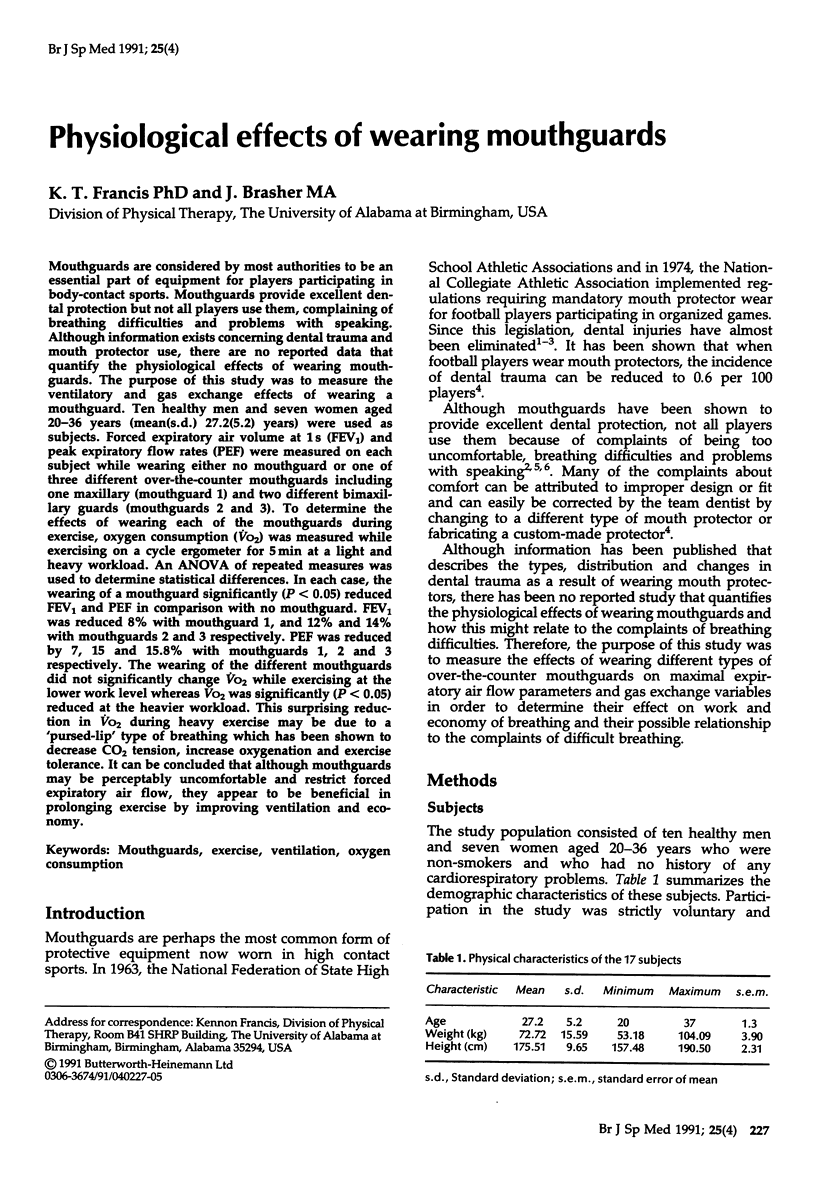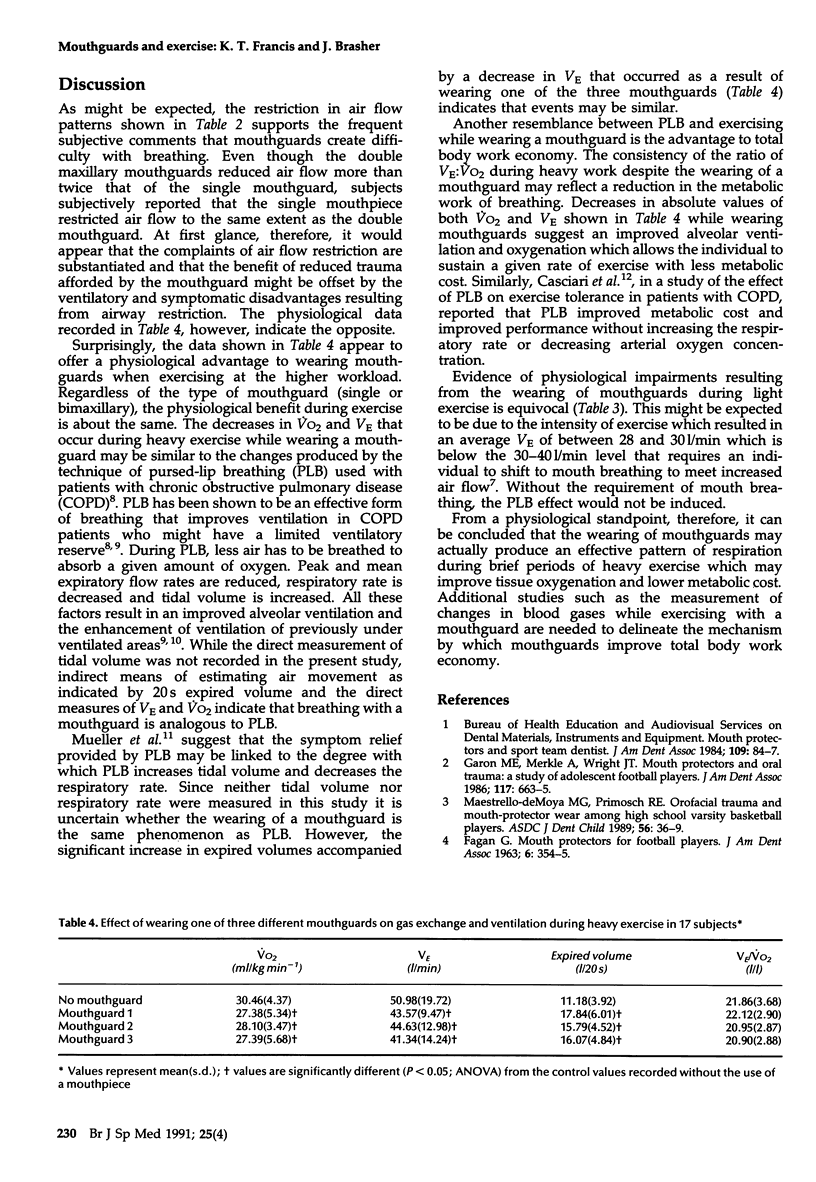Abstract
Mouthguards are considered by most authorities to be an essential part of equipment for players participating in body-contact sports. Mouthguards provide excellent dental protection but not all players use them, complaining of breathing difficulties and problems with speaking. Although information exists concerning dental trauma and mouth protector use, there are no reported data that quantify the physiological effects of wearing mouthguards. The purpose of this study was to measure the ventilatory and gas exchange effects of wearing a mouthguard. Ten healthy men and seven women aged 20-36 years (mean(s.d.) 27.2(5.2) years) were used as subjects. Forced expiratory air volume at 1 s (FEV1) and peak expiratory flow rates (PEF) were measured on each subject while wearing either no mouthguard or one of three different over-the-counter mouthguards including one maxillary (mouthguard 1) and two different bimaxillary guards (mouthguards 2 and 3). To determine the effects of wearing each of the mouthguards during exercise, oxygen consumption (VO2) was measured while exercising on a cycle ergometer for 5 min at a light and heavy workload. An ANOVA of repeated measures was used to determine statistical differences. In each case, the wearing of a mouthguard significantly (P less than 0.05) reduced FEV1 and PEF in comparison with no mouthguard. FEV1 was reduced 8% with mouthguard 1, and 12% and 14% with mouthguards 2 and 3 respectively. PEF was reduced by 7, 15 and 15.8% with mouthguards 1, 2 and 3 respectively. The wearing of the different mouthguards did not significantly change VO2 while exercising at the lower work level whereas VO2 was significantly ( P < 0.05) reduced at the heavier workload. This surprising reduction in VO2 during heavy exercise may be due to a 'pursed-lip' type of breathing which has been shown to decrease CO2 tension, increase oxygenation and exercise tolerance. It can be concluded that although mouthguards may be perceptably uncomfortable and restrict forced expiratory air flow, they appear to be beneficial in prolonging exercise by improving ventilation and economy.
Full text
PDF




Images in this article
Selected References
These references are in PubMed. This may not be the complete list of references from this article.
- Casciari R. J., Fairshter R. D., Harrison A., Morrison J. T., Blackburn C., Wilson A. F. Effects of breathing retraining in patients with chronic obstructive pulmonary disease. Chest. 1981 Apr;79(4):393–398. doi: 10.1378/chest.79.4.393. [DOI] [PubMed] [Google Scholar]
- Chapman P. J. Players' attitudes to mouthguards and prevalence of orofacial injuries in the 1987 U.S. Rugby Football Team. Am J Sports Med. 1989 Sep-Oct;17(5):690–691. doi: 10.1177/036354658901700518. [DOI] [PubMed] [Google Scholar]
- Garon M. W., Merkle A., Wright J. T. Mouth protectors and oral trauma: a study of adolescent football players. J Am Dent Assoc. 1986 May;112(5):663–665. doi: 10.14219/jada.archive.1986.0063. [DOI] [PubMed] [Google Scholar]
- Ingram R. H., Jr, Schilder D. P. Effect of pursed lips expiration on the pulmonary pressure-flow relationship in obstructive lung disease. Am Rev Respir Dis. 1967 Sep;96(3):381–388. doi: 10.1164/arrd.1967.96.3.381. [DOI] [PubMed] [Google Scholar]
- Maestrello-deMoya M. G., Primosch R. E. Orofacial trauma and mouth-protector wear among high school varsity basketball players. ASDC J Dent Child. 1989 Jan-Feb;56(1):36–39. [PubMed] [Google Scholar]
- Mueller R. E., Petty T. L., Filley G. F. Ventilation and arterial blood gas changes induced by pursed lips breathing. J Appl Physiol. 1970 Jun;28(6):784–789. doi: 10.1152/jappl.1970.28.6.784. [DOI] [PubMed] [Google Scholar]
- Seals R. R., Jr, Morrow R. M., Kuebker W. A., Farney W. D. An evaluation of mouthguard programs in Texas high school football. J Am Dent Assoc. 1985 Jun;110(6):904–909. doi: 10.14219/jada.archive.1985.0005. [DOI] [PubMed] [Google Scholar]
- Thoman R. L., Stoker G. L., Ross J. C. The efficacy of pursed-lips breathing in patients with chronic obstructive pulmonary disease. Am Rev Respir Dis. 1966 Jan;93(1):100–106. doi: 10.1164/arrd.1966.93.1.100. [DOI] [PubMed] [Google Scholar]





